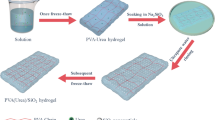Abstract
Biodegradable polymer scaffolds have been used to engineer new tissues or organs by culturing cells on them. The degradation, structure and properties of fibrous nonwoven poly(glycolic acid) (PGA) scaffolds (2 mm thick and 10 mm in diameter) were studied over 9 weeks in tissue culture medium at 37°C under mixing condition. After 3 days of in vitro culture, the mass of the scaffolds increased slightly (5.6%) due to hydration and/or adsorption, but it decreased thereafter. After 9 weeks, only 12.5% of the mass were retained. The melting point of the scaffolds decreased from 218.1°C to 186.0°C in the first 3 weeks, as measured with differential scanning calorimetry (DSC). No melting peak could be identified for later times (6 weeks and 9 weeks). The crystallinity of the scaffolds doubled over the first 11 days, but decreased thereafter. The glass transition temperature of the degrading scaffolds (36–39°C) was lower than that of the dry starting scaffolds (40°C) presumably due to the plasticizing effect of absorbed water and other low molecular weight molecules. The PGA scaffolds without cells lost their structural integrity and mechanical strength completely in 2 to 3 weeks. In contrast, the neocartilage constructs regenerated from the PGA scaffolds and bovine chondrocytes kept their structural integrity throughout the in vitro culture study. After 12 weeks of in vitro culture, the biomechanical properties of the neocartilage constructs reached the same orders of magnitude as those of normal bovine cartilage.
Similar content being viewed by others
References
J. E. Murray, J. P. Merrill and J. H. Harrison, Surg. Forum. 6, 432–436 (1955).
N. P. Couch, R. E. Wilson, E. B. Hager and J. E. Murray, Surgery. 59, 183–188 (1966).
R. Langer and J. P. Vacanti, Science. 260, 920–926 (1993).
J. P. Vacanti, M. A. Morse, W. M. Saltzman, A. J. Domb, A. Perez-Atayde and R. Langer, Journal of Pediatric Surgery. 23, 3–9 (1988).
L. B. Johnson, J. Aiken, D. Mooney, B. L. Schloo, L. Griffith-Cima, R. Langer and J. P. Vacanti, Cell Transplantation. 3, 273–281 (1994).
C. A. Vacanti, W. Kim, J. Upton, M. P. Vacanti, D. Mooney, B. Schloo and J. P. Vacanti, Transplantation Proceedings. 25, 1019–1021 (1993).
L. E. Freed, J. C. Marquis, A. Nohria, J. Emmanual, A. G. Mikos and R. Langer, Journal of Biomedical Materials Research. 27, 11–23 (1993).
P. X. Ma, B. Schloo, D. Mooney and R. Langer, Journal of Biomedical Materials Research, in press.
Y. Cao, J. P. Vacanti, X. Ma, K. T. Paige, J. Upton, Z. Chowanski, B. Schloo, R. Langer and C. A. Vacanti, Transplantation Proceedings. 26, 3390–3391 (1994).
G. M. Organ, D. J. Mooney, L. K. Hansen, B. Schloo and J. P. Vacanti, American College of Surgeons Surgical Forum. 44, 432–436 (1993).
G. M. Organ, D. J. Mooney, L. K. Hansen, B. Schloo and J. P. Vacanti, Transplantation Proceedings. 25, 998–1001 (1993).
A. Atala, J. P. Vacanti, C. A. Peters, J. Mandell, A. B. Retik and M. R. Freeman, The Journal of Urology. 148, 658–662 (1992).
C. C. Chu and A. Browning, Journal of Biomedical Materials Research. 22, 699–712 (1988).
Author information
Authors and Affiliations
Rights and permissions
About this article
Cite this article
Ma, P.X., Langer, R. Degradation, Structure and Properties of Fibrous Nonwoven Poly(Glycolic Acid) Scaffolds for Tissue Engineering. MRS Online Proceedings Library 394, 99–104 (1995). https://doi.org/10.1557/PROC-394-99
Published:
Issue Date:
DOI: https://doi.org/10.1557/PROC-394-99




